HCL Technologies Bundle
How did HCL Technologies transform from an Indian startup into a global IT giant?
From its humble beginnings in India to its current global presence, HCL Technologies' story is one of remarkable growth and strategic innovation. Founded in 1976, this Indian IT company has consistently adapted to the ever-evolving technological landscape. This journey highlights the company's ability to anticipate and capitalize on emerging trends, solidifying its position as a leader in the IT services industry.
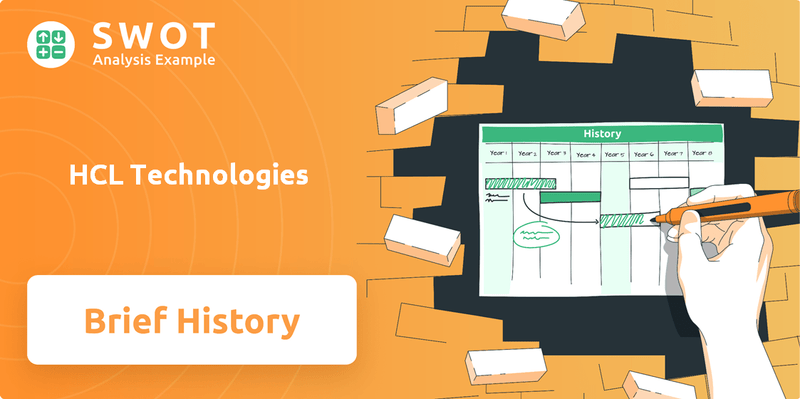
This exploration into the HCL Technologies SWOT Analysis will delve into the brief history of HCL Technologies, tracing its key milestones and the vision of its founder, Shiv Nadar. We'll examine how HCL's early years shaped its core business areas and its impressive global presence today. Understanding the HCL timeline offers valuable insights into the company's evolution and its strategic approach to navigating the competitive IT market.
What is the HCL Technologies Founding Story?
The story of HCL Technologies, an Indian IT company, began on August 11, 1976. It was founded by six engineers: Shiv Nadar, Arjun Malhotra, Ajay Chowdhry, D.S. Puri, Subhash Arora, and Yogesh Vaidya. Their vision was to address the lack of computing infrastructure in India and to foster technological innovation within the country.
The founders, bringing their engineering and technology expertise, aimed to fill this gap. They started by manufacturing microcomputers, a groundbreaking move for India at that time. The company's name, 'Hindustan Computers Limited,' reflected their ambition to become a national technology leader. Initial funding came from bootstrapping and support from their network.
The environment of post-independence India, with its focus on self-reliance, played a significant role in shaping the company's early path. This context helped HCL Technologies establish its presence in the market. The company's early years were marked by a pioneering spirit, as it navigated the challenges of a developing technological landscape. For a deeper dive into the company's operations, consider reading Revenue Streams & Business Model of HCL Technologies.
HCL Technologies was founded in 1976 by six engineers, including Shiv Nadar.
- The initial focus was on manufacturing microcomputers.
- The company aimed to address the computing infrastructure gap in India.
- Early funding came from bootstrapping and personal networks.
- The company's name, 'Hindustan Computers Limited,' reflected its national aspirations.
HCL Technologies SWOT Analysis
- Complete SWOT Breakdown
- Fully Customizable
- Editable in Excel & Word
- Professional Formatting
- Investor-Ready Format
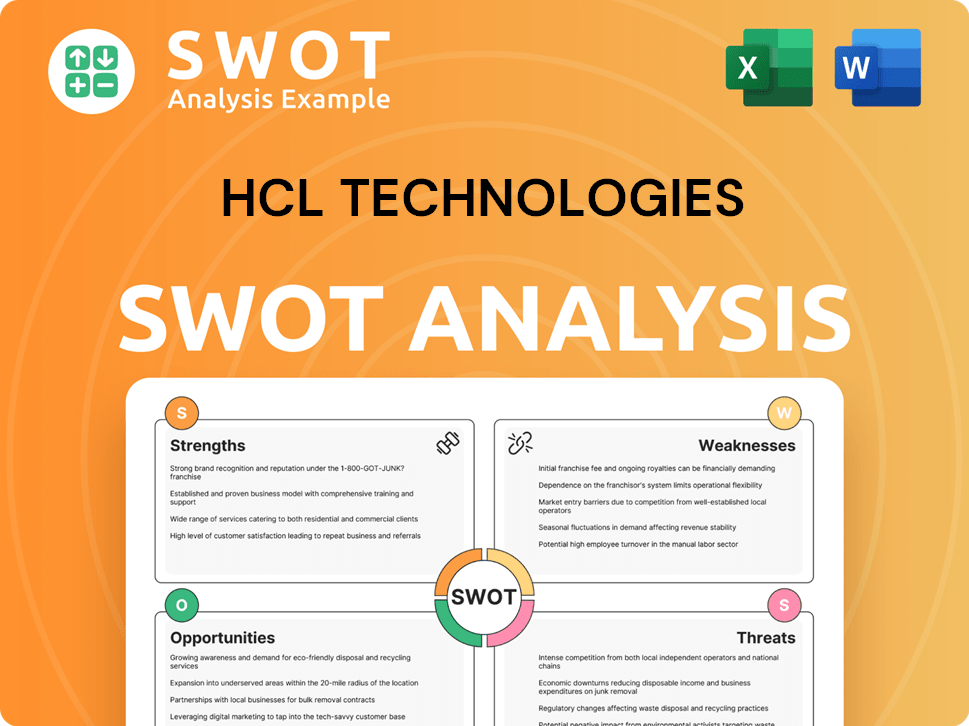
What Drove the Early Growth of HCL Technologies?
The early years of HCL Technologies, a significant chapter in the HCL company history, were marked by pioneering efforts in the Indian hardware market. This period saw the launch of groundbreaking products and the establishment of a strong foundation for future growth. These early initiatives set the stage for HCL's evolution into a global IT services leader.
In the 1980s, HCL, an Indian IT company, introduced India's first indigenous 8-bit microcomputer, the HCL 8C. This was followed by the country's first multi-processor 16-bit microcomputer. These innovations positioned HCL as a key player in the domestic computing sector, showcasing its commitment to technological advancement.
To cater to a growing client base, which included government organizations and large enterprises, HCL expanded its team and established offices across major Indian cities. This expansion was crucial for providing localized support and services. This strategic move helped solidify its presence in the Indian market.
The 1990s marked a pivotal shift for HCL Technologies, recognizing the potential in software services and global IT outsourcing. This led to the creation of HCL Tech, a dedicated software services entity. This strategic pivot was a key milestone in the HCL timeline.
HCL Technologies secured its initial international clients in the late 1990s, expanding its operations in the US and European markets. This expansion was a major step in establishing its global presence. The company's ability to secure international clients was a testament to its growing reputation and capabilities.
HCL Technologies PESTLE Analysis
- Covers All 6 PESTLE Categories
- No Research Needed – Save Hours of Work
- Built by Experts, Trusted by Consultants
- Instant Download, Ready to Use
- 100% Editable, Fully Customizable
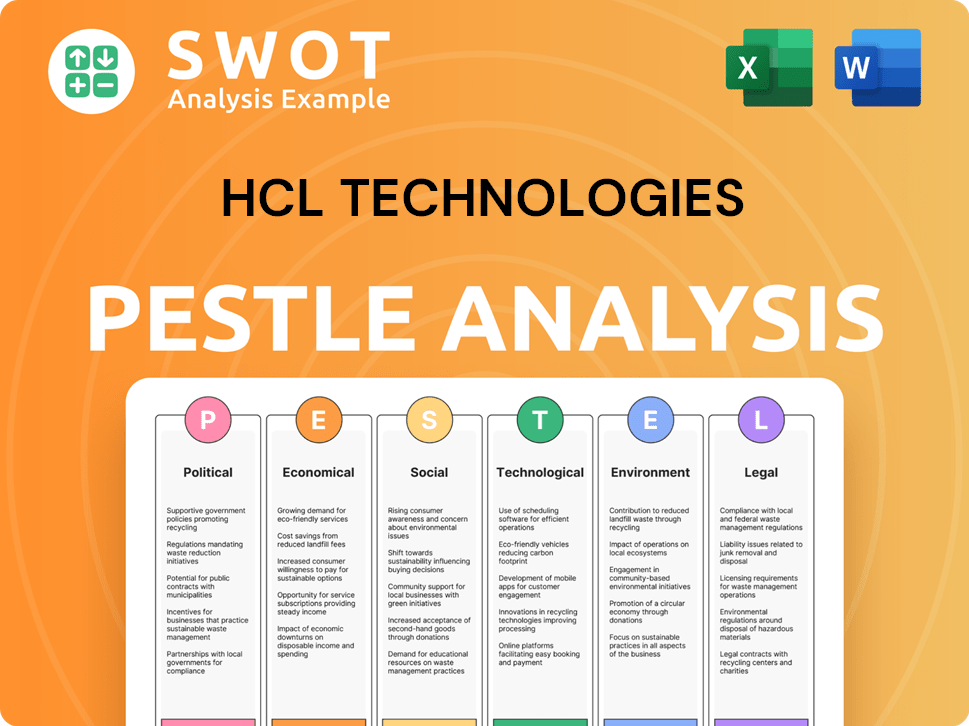
What are the key Milestones in HCL Technologies history?
The HCL company history is marked by significant achievements and strategic shifts. From its inception, HCL Technologies has consistently demonstrated a commitment to innovation and adaptability, evolving from a hardware manufacturer to a global leader in IT services. The company's journey reflects a blend of pioneering spirit and strategic foresight, enabling it to navigate market changes and maintain a strong presence in the competitive IT landscape.
| Year | Milestone |
|---|---|
| Late 1970s | HCL developed India's first indigenous microcomputer, the HCL 8C, marking its entry into the technology sector. |
| 1991 | HCL Technologies was established as a software services division, expanding its focus to IT solutions. |
| 2000s | HCL expanded its global footprint through strategic acquisitions and partnerships, enhancing its service offerings. |
| 2007 | HCL Technologies was listed on the stock exchanges, significantly boosting its visibility and financial capabilities. |
| Mid-2010s | The introduction of the 'Mode 1-2-3' strategy allowed HCL to address diverse IT service needs, from traditional to next-gen solutions. |
| 2023-2024 | HCL Technologies continued to focus on digital transformation, cloud services, and cybersecurity, expanding its market share. |
HCL Technologies has consistently been at the forefront of innovation, particularly in engineering and R&D services. The company's focus on developing industry-first solutions, such as remote infrastructure management, has set it apart in the competitive IT services market. These innovations have not only enhanced HCL's service offerings but have also helped its clients stay ahead of technological advancements.
HCL's development of the HCL 8C was a groundbreaking innovation, establishing the company as a pioneer in the Indian IT sector. This early venture into hardware demonstrated HCL's ability to innovate and adapt to emerging technologies.
HCL has been a leader in providing engineering and R&D services, helping clients innovate in various sectors. This focus has allowed HCL to build deep expertise and offer specialized solutions.
HCL pioneered remote infrastructure management, providing efficient and cost-effective IT solutions. This innovation improved operational efficiency for numerous clients.
HCL has been at the forefront of digital transformation, helping clients adopt new technologies and business models. This includes cloud computing, AI, and data analytics.
HCL's cloud services have enabled clients to improve agility and reduce IT costs. These services include cloud migration, management, and optimization.
With the rise of cyber threats, HCL has enhanced its cybersecurity solutions to protect clients' data and infrastructure. These solutions include threat detection, incident response, and security consulting.
HCL Technologies has faced several challenges, including market downturns and intense competition from both established and emerging IT companies. The dot-com bust in the early 2000s required strategic realignments and cost optimization to maintain its market position. The company's ability to adapt and innovate has been crucial in overcoming these obstacles.
Economic fluctuations, such as the dot-com bust, have tested HCL's resilience. Strategic adjustments and cost management have been essential to navigate these periods.
Competition from global IT giants and emerging players has consistently pushed HCL to innovate. Differentiating its services and expanding its global presence have been key strategies.
Rapid technological advancements, such as the shift to cloud computing and AI, require continuous adaptation. HCL has invested in new technologies to stay relevant.
Attracting and retaining skilled IT professionals is a constant challenge in the competitive market. HCL invests in employee development and a positive work environment.
Global events can impact HCL's operations and client relationships. The company manages these risks through diversification and strategic planning.
Sustaining growth in a dynamic market requires continuous innovation and expansion. HCL's strategic initiatives focus on new markets and service offerings.
HCL Technologies Business Model Canvas
- Complete 9-Block Business Model Canvas
- Effortlessly Communicate Your Business Strategy
- Investor-Ready BMC Format
- 100% Editable and Customizable
- Clear and Structured Layout
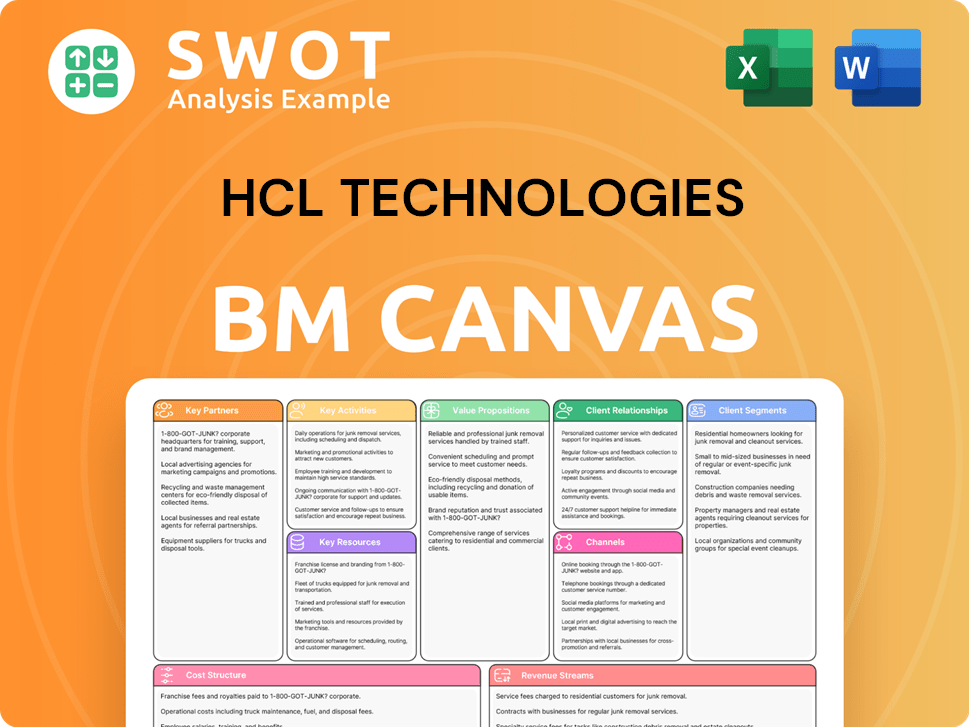
What is the Timeline of Key Events for HCL Technologies?
The HCL Technologies company history is a story of innovation and expansion, starting in 1976 as Hindustan Computers Limited. Over the years, it has grown from a hardware manufacturer to a global IT services leader. Key milestones include the launch of India's first microcomputer, the establishment of HCL Tech, and a successful IPO. Strategic acquisitions and a focus on emerging technologies have propelled its growth, solidifying its position in the industry.
| Year | Key Event |
|---|---|
| 1976 | Founded as Hindustan Computers Limited (HCL), focusing on hardware manufacturing. |
| 1980 | Launched India's first indigenous microcomputer. |
| 1991 | Established HCL Tech, marking its entry into software services. |
| 1999 | HCL Technologies went public with an IPO. |
| 2001 | Established global delivery centers to expand international operations. |
| 2008 | Acquired Axon Group for US$650 million, expanding consulting capabilities. |
| 2015 | Introduced its 'Mode 1-2-3' strategy to address evolving client needs. |
| 2019 | Acquired select IBM software products for US$1.8 billion, enhancing its product portfolio. |
| 2023 | Reported strong financial performance, with a focus on digital transformation and cloud services. |
| 2024 | Continues to strengthen its AI and GenAI capabilities, expanding partnerships and solutions. |
HCL Technologies is significantly investing in Artificial Intelligence and Generative AI. This includes expanding partnerships and developing new solutions to meet the growing demand for AI-driven services. The company aims to integrate AI across its service offerings to provide innovative solutions to clients. This focus is expected to drive growth and enhance its competitive edge in the market.
Cloud computing remains a critical area of focus for HCL Technologies. The company is expanding its cloud services portfolio, including infrastructure, platform, and software as a service. This expansion is driven by the increasing demand for cloud solutions and the company's commitment to helping clients migrate and manage their cloud environments efficiently. The company's cloud revenue is expected to grow significantly.
Cybersecurity is a key strategic area for HCL Technologies. The company is investing in strengthening its cybersecurity capabilities to protect clients from evolving threats. This includes developing advanced security solutions and expanding its cybersecurity services. The company's focus on cybersecurity is critical in today's digital landscape.
HCL Technologies is targeting sustainable growth by focusing on emerging technologies and expanding its global presence. The company is committed to innovation and client-centricity, which are key to its long-term success. It aims to achieve sustainable growth by investing in research and development and expanding into key growth markets. The company is focused on creating value for its stakeholders.
HCL Technologies Porter's Five Forces Analysis
- Covers All 5 Competitive Forces in Detail
- Structured for Consultants, Students, and Founders
- 100% Editable in Microsoft Word & Excel
- Instant Digital Download – Use Immediately
- Compatible with Mac & PC – Fully Unlocked
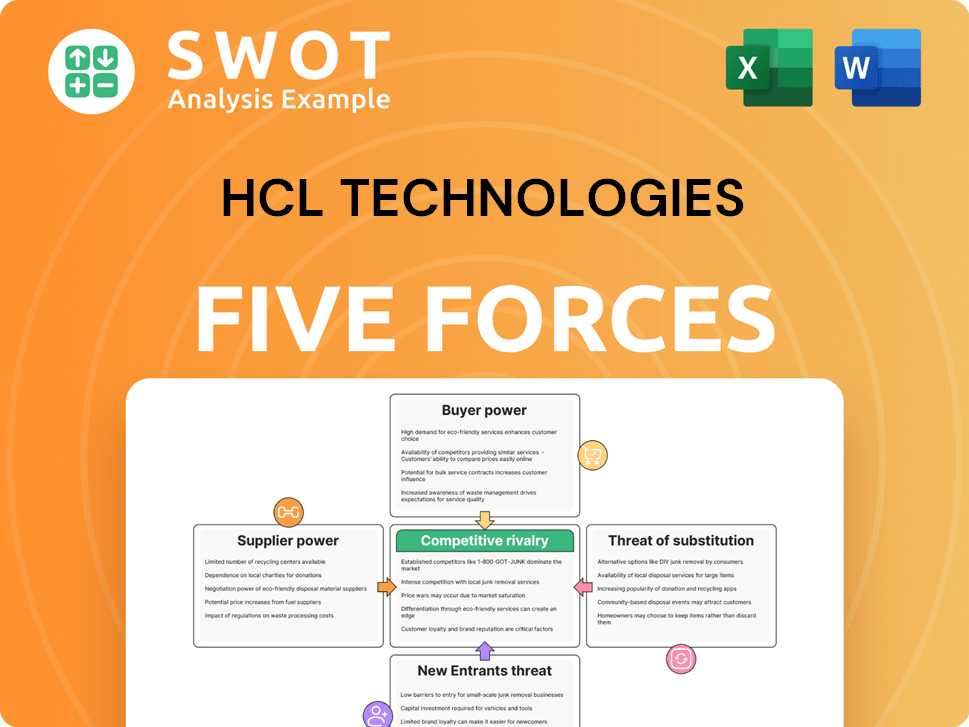
Related Blogs
- What is Competitive Landscape of HCL Technologies Company?
- What is Growth Strategy and Future Prospects of HCL Technologies Company?
- How Does HCL Technologies Company Work?
- What is Sales and Marketing Strategy of HCL Technologies Company?
- What is Brief History of HCL Technologies Company?
- Who Owns HCL Technologies Company?
- What is Customer Demographics and Target Market of HCL Technologies Company?
Disclaimer
All information, articles, and product details provided on this website are for general informational and educational purposes only. We do not claim any ownership over, nor do we intend to infringe upon, any trademarks, copyrights, logos, brand names, or other intellectual property mentioned or depicted on this site. Such intellectual property remains the property of its respective owners, and any references here are made solely for identification or informational purposes, without implying any affiliation, endorsement, or partnership.
We make no representations or warranties, express or implied, regarding the accuracy, completeness, or suitability of any content or products presented. Nothing on this website should be construed as legal, tax, investment, financial, medical, or other professional advice. In addition, no part of this site—including articles or product references—constitutes a solicitation, recommendation, endorsement, advertisement, or offer to buy or sell any securities, franchises, or other financial instruments, particularly in jurisdictions where such activity would be unlawful.
All content is of a general nature and may not address the specific circumstances of any individual or entity. It is not a substitute for professional advice or services. Any actions you take based on the information provided here are strictly at your own risk. You accept full responsibility for any decisions or outcomes arising from your use of this website and agree to release us from any liability in connection with your use of, or reliance upon, the content or products found herein.